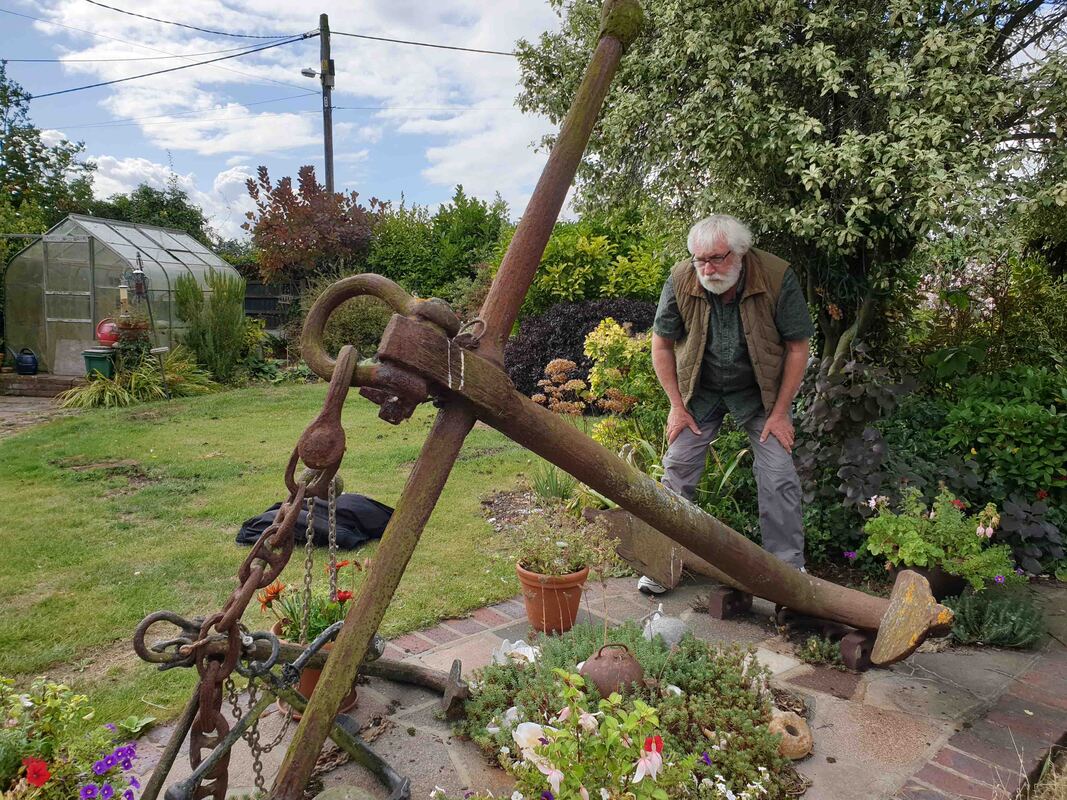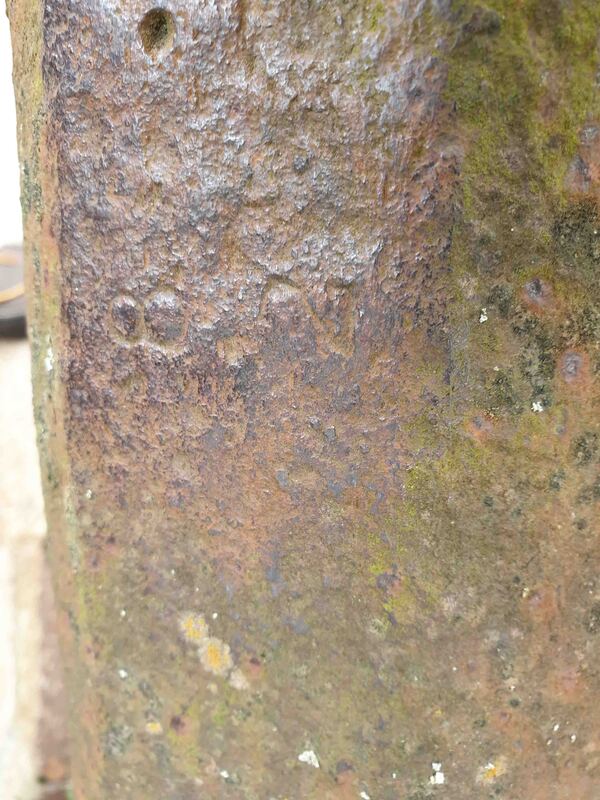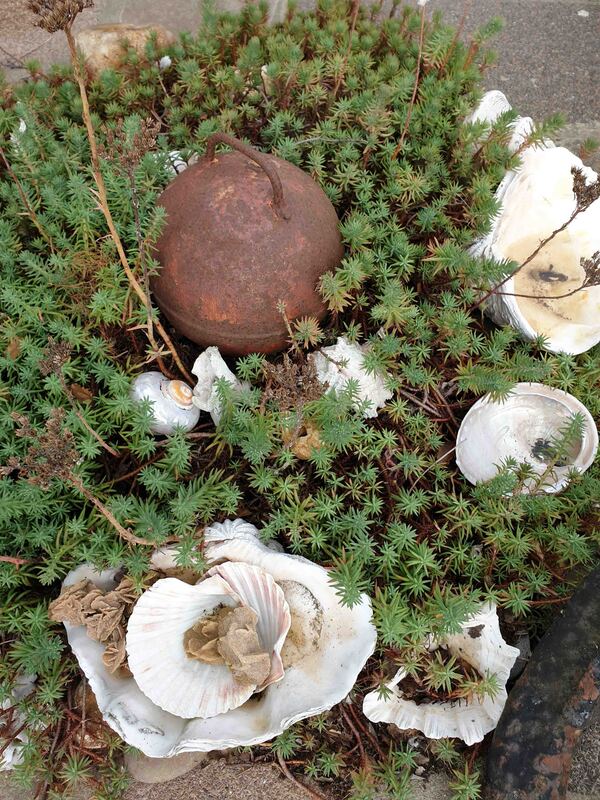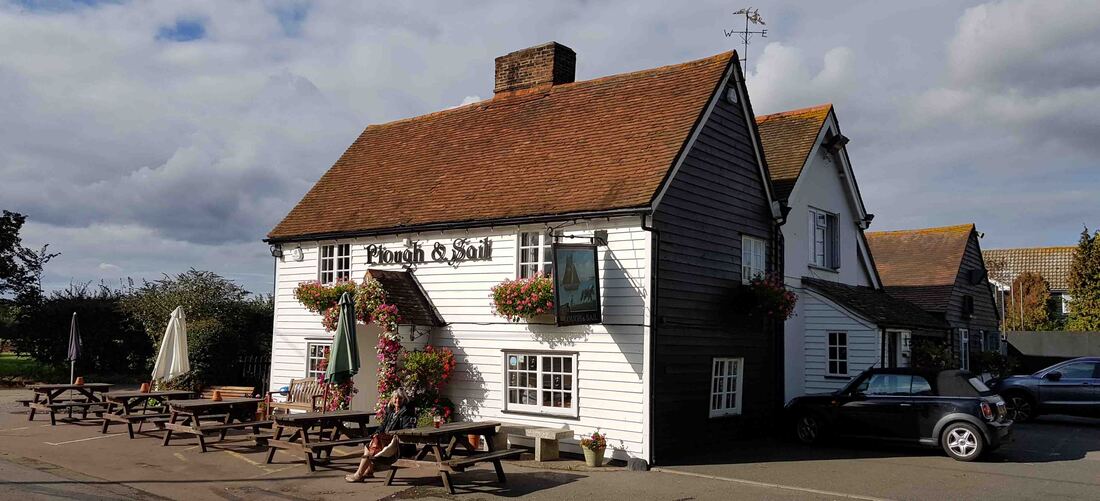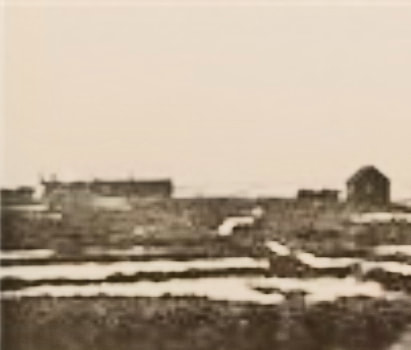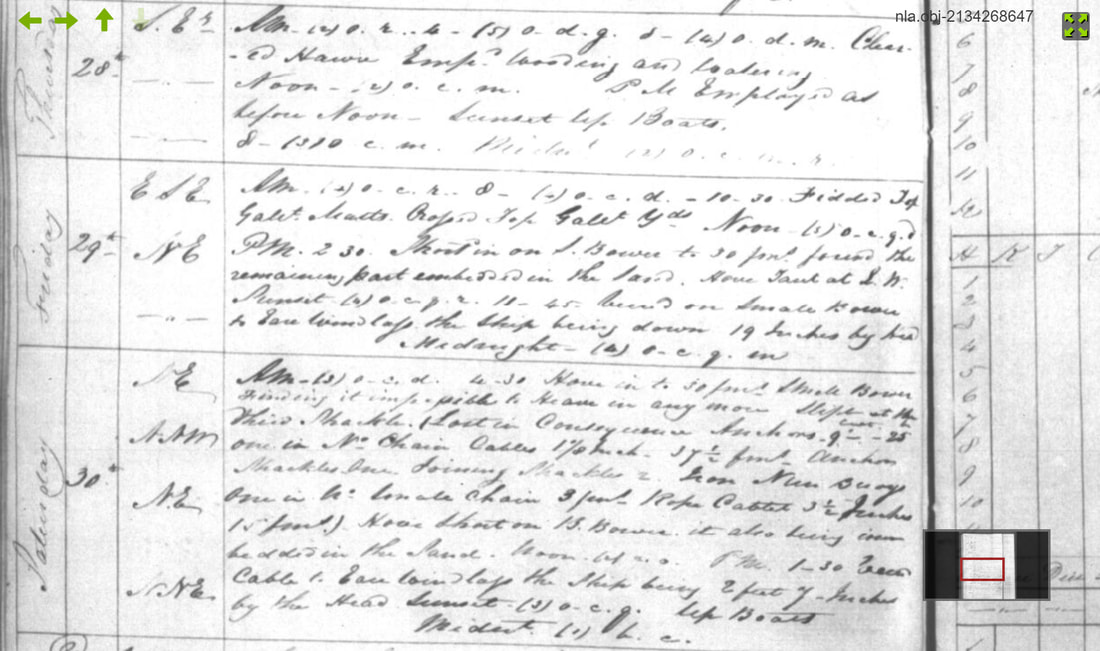HMS BEAGLE - Watch Vessel No. 7
This troubled year, 2020, marks the bicentenary of the launch of HMS Beagle - so is fitting that her graving dock at the Essex village of Paglesham should have entered England's Register of National Heritage as a scheduled monument.
"Darwin himself seems to have had no idea that his former ship ended her life so close to his home in Kent," [Dr R. Prescott]
Coast Guard Watch Vessel No. 7
''When the Beagle was first established at Paglesham, she was stripped down and her upper masts and spars were taken away because she was not expected to be moved again. However, in 1850 there was a small flurry of activity: On June 12 a group of “Oyster Company Captains”—merchants of the Burnham area—petitioned the collector at Maldon that the Beagle be removed. She was moored in the middle of a rather narrow river, and at low tide vessels had difficulty getting around her and often fell foul of her moorings. This was confirmed by the “chief officer of the Beagle” (actually a boatman), and it was suggested that she be moved to the shore. Eventually, after much correspondence, she was tied up on the Paglesham side of the river. Five years pass before the next reference to the Beagle. Although an official agreement had been drawn up for the use of the land adjoining the ship, the fees had never been paid. Lawyers for the landowner, Lady Olivia Sparrow, were naturally suing for payment, which, after more delays, was made." (Keith Thomson - US Scientist Vol.3)
"After this we learn no more from the customs records. In 1859 the navy took over the operation of the Coastguard, and following this change, the watch vessels were stripped of the last vestiges of their former individuality and character. On May 25, 1863, all watch vessels were given numbers; H.M.S. Beagle became W.V.7. In 1870, even the decaying hulk of W.V.7 became superfluous, and on May 13 what remained of her was sold to Murray and Trainer for £525. After that, her fate is unknown. Some authors state that the Beagle was sold to the Japanese navy as a training ship. In fact, this was the fate of the next ship in the history of the Royal Navy to bear the name Beagle, a paddle vessel armed with two 68-pound mortars, which saw service in the Crimean War in 1854. She was sold to Japan in 1863 and renamed Kanko. Of the nine vessels to have borne the name Beagle, the vessel in which Darwin and FitzRoy sailed was the third." (Keith Thomson - US Scientist Vol.3)

The markings indicate the centre of gravity - the figures "8 over 2" denote the weight - i.e. half a ton.
The crown between the letters B & T refer to the Board of Trade. These confirm the anchor to be an 1842 Admiralty Patent Stream (Kedge) Anchor.
Source Watch Vessel No.7 p. 48 by Ann Boulter
The crown between the letters B & T refer to the Board of Trade. These confirm the anchor to be an 1842 Admiralty Patent Stream (Kedge) Anchor.
Source Watch Vessel No.7 p. 48 by Ann Boulter
The Beagle's Grave
The mystery of what happened to the ship that ferried
Charles Darwin around the world may have been solved.
A team led by Dr Robert Prescott of the University of St Andrews has located what they believe are the remains of HMS Beagle beneath an Essex marsh.
To explore the site further, technology designed for the UK's recent ill-fated mission to Mars is being considered.
The two quests are linked by Colin Pillinger, who named his Red-Planet craft Beagle 2 after its 200-year-old predecessor.
Sophisticated radar technology was used to detect signs of wood and metal that may belong to the bottom of HMS Beagle, on which Darwin gathered the natural specimens he used to develop his theory of evolution.
The ship's remains are embedded in five metres of mud at a site near Potton Island.
Papers of Admiral John Lort Stokes
A team led by Dr Robert Prescott of the University of St Andrews has located what they believe are the remains of HMS Beagle beneath an Essex marsh.
To explore the site further, technology designed for the UK's recent ill-fated mission to Mars is being considered.
The two quests are linked by Colin Pillinger, who named his Red-Planet craft Beagle 2 after its 200-year-old predecessor.
Sophisticated radar technology was used to detect signs of wood and metal that may belong to the bottom of HMS Beagle, on which Darwin gathered the natural specimens he used to develop his theory of evolution.
The ship's remains are embedded in five metres of mud at a site near Potton Island.
Papers of Admiral John Lort Stokes
Darwin's Beagle ship 'found
 Dr. Robert Prescott - BBC image
Dr. Robert Prescott - BBC image
The mystery of what happened to the ship that ferried Charles Darwin around the world may have been solved.
A team led by Dr Robert Prescott of the University of St Andrews has located what they believe are the remains of HMS Beagle beneath an Essex marsh.
To explore the site further, technology designed for the UK's recent ill-fated mission to Mars is being considered.
The two quests are linked by Colin Pillinger, who named his Red-Planet craft Beagle 2 after its 200-year-old predecessor.
Sophisticated radar technology was used to detect signs of wood and metal that may belong to the bottom of HMS Beagle, on which Darwin gathered the natural specimens he used to develop his theory of evolution.
The ship's remains are embedded in five metres of mud at a site near Potton Island.
A team led by Dr Robert Prescott of the University of St Andrews has located what they believe are the remains of HMS Beagle beneath an Essex marsh.
To explore the site further, technology designed for the UK's recent ill-fated mission to Mars is being considered.
The two quests are linked by Colin Pillinger, who named his Red-Planet craft Beagle 2 after its 200-year-old predecessor.
Sophisticated radar technology was used to detect signs of wood and metal that may belong to the bottom of HMS Beagle, on which Darwin gathered the natural specimens he used to develop his theory of evolution.
The ship's remains are embedded in five metres of mud at a site near Potton Island.
"Darwin himself seems to have had no idea that his former ship ended her life so close to his home in Kent." Dr Robert Prescott, University of St Andrews
After circumnavigating the globe, the ship was used as a watch vessel to combat smuggling in the Southend Coastguard District.
Researchers must now decide whether it is feasible to recover what remains of the ship.
As yet, the team have not secured funding to do so.
But archaeologists may be able to explore the site in other ways.
After circumnavigating the globe, the ship was used as a watch vessel to combat smuggling in the Southend Coastguard District.
Researchers must now decide whether it is feasible to recover what remains of the ship.
As yet, the team have not secured funding to do so.
But archaeologists may be able to explore the site in other ways.
Famous journey
Professor Pillinger told BBC News Online that the "mole" used on Beagle 2, a device developed to burrow beneath the Martian soil, could be fitted with a camera to explore beneath the mud where HMS Beagle may now lie.
Dr Prescott and Professor Pillinger set up the Beagle Ship Research Group in 2000, with the aim of finding out what became of the 27m-long Royal Navy brig after its famous journey. Dr Prescott and his colleagues studied historical maps and correspondence between the coastguard officers and local oyster fishermen.
Professor Pillinger told BBC News Online that the "mole" used on Beagle 2, a device developed to burrow beneath the Martian soil, could be fitted with a camera to explore beneath the mud where HMS Beagle may now lie.
Dr Prescott and Professor Pillinger set up the Beagle Ship Research Group in 2000, with the aim of finding out what became of the 27m-long Royal Navy brig after its famous journey. Dr Prescott and his colleagues studied historical maps and correspondence between the coastguard officers and local oyster fishermen.
The last location of the vessel was revealed by a manuscript chart produced by the Photographic Office Survey Team in 1847. It shows the ship moored in the middle of the River Roach. But in 1850, the ship was moved ashore, following complaints from the oyster fishermen that her four anchor lines were blocking the passage of their boats up and down the fairway. The correspondence between the coastguard controller-general and his officers pointed to a particular spot on the shore where it was deemed HMS Beagle should be berthed. "We did an archaeological survey and found lots of mid-Victorian pottery that came from the ship," Dr Prescott told BBC News Online. "We then did a remote [radar] sensing survey of the site which revealed the shape and the size of the dock and showed an anomaly on the bottom which is the one we think is the ship."
On 13th May 1870, with smuggling in decline, the Beagle was sold for scrap to Murray and Trainer for £525. Three months later half a ton of her Pig Ballast, was sold for £1.10.0. It is thought the ship was stripped of it's fixtures and fittings before being dismantles to the waterline. The construction of
Dr Prescott added that the bilges, near the bottom of the ship, might have collected sludge and discarded objects from her travels.
Pollen and other biological material from these bilges could be analysed to reveal more about the history of the ship's voyages.
"Darwin himself seems to have had no idea that his former ship ended her life so close to his home in Kent," said Dr Prescott.
Both Pillinger & Prescott are dead.
Dr Prescott added that the bilges, near the bottom of the ship, might have collected sludge and discarded objects from her travels.
Pollen and other biological material from these bilges could be analysed to reveal more about the history of the ship's voyages.
"Darwin himself seems to have had no idea that his former ship ended her life so close to his home in Kent," said Dr Prescott.
Both Pillinger & Prescott are dead.
HMS Kangaroo
Broadly similar vessels which both ended their days as His Majesty's Watch Vessels were HMS Beagle was launched in 1820 - 90ft, 235 tons - became HMWV 1863-1870 and HMS Kangaroo was launched in 1852 -105ft 383 tons - became HMWV 1872-1890. The situation of the two vessels as depicted in the artist's impression below would have been very similar. If Beagle was broken up in situ which is probable after 7 years settling in the mud dock - then economics would have determined the height above the keel where it would have ceased to be viable to continue.
The Watch House
Rochford District Community Archive images show the saltings at Paglesham - the Watch House would have been just out of shot to the left of the bow of the large vessel which is in the right location for the Beagle.
"This old structure has long since disappeared. It was probably in the area where oyster beds are behind a chain link fence with a newer brick & concrete shed and two derelict barges rusting into the mud. This is just beyond where the remains of Charles Darwin’s HMS Beagle are thought to have sunk into the mud and, the second picture, an old postcard, “Paglesham, Oyster Pits”, does show a large hull in an appropriate position, on the left. The “Shed on Stilts” position would have been just off the postcard picture, to the left. Old maps indicate a Watch House in this sort of position…" Nathan Bell
The Beagle graving dock and the Watch House are fine but the angle doesn't really work. If that is Beagle, which drew 12ft, she would at best have been some 24ft from deck to keel high and 90ft long - so her height being less than a third of her length - in which case then the hull in the image cannot be her. Even if she is afloat in the image, the one in the image is much longer and the stern is wrong - but no other ship is known to have used her ingo.
The Quest for the Beagle Anchors in the Victoria River NT.
Anchors as at start of 2nd voyage
Fitzroy's exhaustive refit of the Beagle cost nearly as much as she had cost to build. She was effectively reconstructed, left home with 14 chronometers in a specially constructed cupboard and double her normal complement of anchors. She may have been amongst the first 100 ships to receive Muntz's new Yellow Metal copper/zinc alloy sheathing.
- 5 x 14cwt (635kg) bowers (These are the main anchors – usually found at the bow of the ship.)
- 2 x 7cwt (317.5kg) stream anchors (These are medium-sized anchors used to help stabilize the ship in tidal regions or river channels.) Paglesham 1942 anchor 8.5 cwt (385.5kg)
- 4 x 3 cwt (136kg) kedge anchors (These are light anchors usually used for helping to turn the ship while it is moving – a technique called “kedging”.)
- There was also a combined 1100 fathoms – 6600 feet or roughly 2 km – of chains and cables to be used with the anchors.
Bower anchor – One of two carried at the bows and permanently attached to the anchor cable, ready for immediate use. There was usually a Best Bower Anchor and a Small Bower Anchor, which weighed the same, but were so named for the bow on which they were placed, that on the starboard bow being ‘best’ and that on the larboard, or port, being ‘small’.
Bower anchor cable, or bower cable – the cable fixed to the bower anchor. ‘Best’ and ‘small’ applies also to the cables serving their respective anchors.
Bower anchor cable, or bower cable – the cable fixed to the bower anchor. ‘Best’ and ‘small’ applies also to the cables serving their respective anchors.
These anchors for the 2nd & 3rd voyages were more brittle than the ones that became available in the early 1840s. Beagle had previous for breaking anchors which suggests that some extra care may be advisable when considering extraction.
The suggested cause of the loss of the two bower anchors is quicksand - presumably as no other explanation was forthcoming. In his first-hand account, Commander Pasco writes that:- "The common notion among the crew in the forecastle was, that when we returned to Woolwich we should find the anchors had reached the dockyard before us." This misconception persisted until a decade after the anchors were located by a team led by entrepreneur Dick Smith.
Pasco describes their situation upon trying to quit Holdfast Reach in the Victoria River:- "The in-shore anchor was in five fathoms at low water, and the off-shore anchor in ten fathoms on a stiff mud bottom; but when, about six weeks later, we attempted to weigh and depart, the in-shore cable was hove in at low water to the first shackle only, which was twelve and a half fathoms from the anchor, thus leaving fully seventy fathoms unaccounted for. The cable was well stoppered in hope of the rising tide helping to draw it out of the mud, but, so unyielding was it, that the ship was carried down by the head until the strain broke the hawse-pipe, and compelled us to slip the cable at the first shackle and lose the anchor. The other anchor was then hove short at next low tide with similar result, there being the same amount of chain unaccounted for." [A Roving Commission. Naval Reminiscences - Commander Crawford Pasco R.N. Published by George Robertson and Co., 1897]
This is the Pasco who was aboard Owen Stanley's HMS Britomart when he met a mate aboard the Beagle at Port Essington in 1839 & they swapped ships - he was involved in the attempted rescue of Joseph Forbes, the sole survivor of the pirates taking the Stedcombe in 1825 and ended up the recipient of Forbes' pigtail which he had given to his rescuer Capt. Watson. It was Pasco's father, Admiral John Pascoe, who was aboard Victory & raised the famous Trafalgar signal "England Expects" which for Nelson originally had "Nelson confides" then "England confides'' until Pasco proposed "expects" as ''confides'' is not a word in Popham's Signals Vocabulary so would have had to be spelt out by the letter.
Pasco describes their situation upon trying to quit Holdfast Reach in the Victoria River:- "The in-shore anchor was in five fathoms at low water, and the off-shore anchor in ten fathoms on a stiff mud bottom; but when, about six weeks later, we attempted to weigh and depart, the in-shore cable was hove in at low water to the first shackle only, which was twelve and a half fathoms from the anchor, thus leaving fully seventy fathoms unaccounted for. The cable was well stoppered in hope of the rising tide helping to draw it out of the mud, but, so unyielding was it, that the ship was carried down by the head until the strain broke the hawse-pipe, and compelled us to slip the cable at the first shackle and lose the anchor. The other anchor was then hove short at next low tide with similar result, there being the same amount of chain unaccounted for." [A Roving Commission. Naval Reminiscences - Commander Crawford Pasco R.N. Published by George Robertson and Co., 1897]
This is the Pasco who was aboard Owen Stanley's HMS Britomart when he met a mate aboard the Beagle at Port Essington in 1839 & they swapped ships - he was involved in the attempted rescue of Joseph Forbes, the sole survivor of the pirates taking the Stedcombe in 1825 and ended up the recipient of Forbes' pigtail which he had given to his rescuer Capt. Watson. It was Pasco's father, Admiral John Pascoe, who was aboard Victory & raised the famous Trafalgar signal "England Expects" which for Nelson originally had "Nelson confides" then "England confides'' until Pasco proposed "expects" as ''confides'' is not a word in Popham's Signals Vocabulary so would have had to be spelt out by the letter.
The men of the Beagle were unaware of the nature of Tropical Cyclones which have an 'eye' causing the observer to experience winds which move through 180 degrees as the eye passes. In a river at night, it is depressingly easy to turn 180 degrees and not be aware of the fact - in the presence of a Cyclone anything is possible. When at anchor in a tidal river the stream determines how she lies - so with two bower anchors deployed she has done a 360 degree pirouette - fouled her anchor lines - and been forced to cut them away. A tidal surge & pressure changes compound confusion. From the drawing above it is seen that there is only a forward chain locker - 2,400 feet of chain is a lot of weight. The Beagle anchors in the Victoria River represent two anchors at 1 ton each & at least 40 tons of knotted chain. Cutting old iron chain underwater with a torch can be a dangerous undertaking.
The Beagle Log 28, 29 & 30 November 1839
Stated that they are the Bower (Starboard) & Small Bower (Port) main anchors - 635kg each & 45 fathoms (270ft) of chain. It is usual to use Stream Anchors when mooring in relatively sheltered rivers as they are easier to deploy and retrieve in confined & shallow waters with moderate to low run at the end of the Dry Season. Perhaps the poor weather encouraged the use of the main anchors.
This circumstance suggested the appropriate name of Holdfast Reach for this locality; and perhaps in some future generations, when this part of the world has undergone the changes that seems destined for it, the archaeologist of Victoria River may in vain puzzle his wits with speculations concerning the Beagle's anchors. JL Stokes
DEAD TURTLES ON THE SHORE.
Behind some very low scattered sandhills that form it, fronting a mangrove flat, we beheld great numbers of dead turtles, that seemed to have repaired thither of their own accord to die. They were lying on their bellies, with their shells for the most part uninjured, though some were turned over, and showed other signs of visits from the natives. A few skeletons of a large bustard* were also seen there, so that the place had quite the appearance of a cemetery, and reminded me of a spot on the River Gallegos in Patagonia, where the guanacos (a kind of llama) assemble to pay the debt of nature, and leave their bones to whiten the surface of the plain. Never before, on any occasion, had we seen dead turtles in any similar position; how they could have got there was a mystery, unless we suppose them to have been thrown up by some earthquake wave. They had evidently not been transported thither by the hand of man, though, as I have observed, some of the natives who thinly inhabit this district, finding them there, ready to their hand, had availed themselves of the gifts of fortune. I could not help, as I gazed on this remarkable scene, calling to mind the marvellous elephant cemetery described by Sinbad the Sailor. It is possible that the observation of some similar phenomenon may have suggested to the imagination of the authors of the Thousand and One Nights their romantic fiction. At any rate an air of mystery will always hang round Turtle Point until the facts I have mentioned shall have been explained.
(*Footnote. A specimen of one of them was brought away and deposited in the Museum at Sydney.)
The nature of this part of the country I have before described on my visit to Indian Hill. A ridge of breakers ran off north a couple of miles from our station; a low point, bearing West 16 degrees South about eight or nine miles, with an opening trending in south intervening, with some slightly elevated land bearing South 34 degrees West about four or five leagues, terminated our view to the westward. We found the tide much weaker on this side of the entrance, not exceeding three miles an hour; the stream ran up three-quarters of an hour after high-water. The times of high-water for the last three days had been most unaccountably the same. Stokes Beagle Diary in Beagle Notes 2
Behind some very low scattered sandhills that form it, fronting a mangrove flat, we beheld great numbers of dead turtles, that seemed to have repaired thither of their own accord to die. They were lying on their bellies, with their shells for the most part uninjured, though some were turned over, and showed other signs of visits from the natives. A few skeletons of a large bustard* were also seen there, so that the place had quite the appearance of a cemetery, and reminded me of a spot on the River Gallegos in Patagonia, where the guanacos (a kind of llama) assemble to pay the debt of nature, and leave their bones to whiten the surface of the plain. Never before, on any occasion, had we seen dead turtles in any similar position; how they could have got there was a mystery, unless we suppose them to have been thrown up by some earthquake wave. They had evidently not been transported thither by the hand of man, though, as I have observed, some of the natives who thinly inhabit this district, finding them there, ready to their hand, had availed themselves of the gifts of fortune. I could not help, as I gazed on this remarkable scene, calling to mind the marvellous elephant cemetery described by Sinbad the Sailor. It is possible that the observation of some similar phenomenon may have suggested to the imagination of the authors of the Thousand and One Nights their romantic fiction. At any rate an air of mystery will always hang round Turtle Point until the facts I have mentioned shall have been explained.
(*Footnote. A specimen of one of them was brought away and deposited in the Museum at Sydney.)
The nature of this part of the country I have before described on my visit to Indian Hill. A ridge of breakers ran off north a couple of miles from our station; a low point, bearing West 16 degrees South about eight or nine miles, with an opening trending in south intervening, with some slightly elevated land bearing South 34 degrees West about four or five leagues, terminated our view to the westward. We found the tide much weaker on this side of the entrance, not exceeding three miles an hour; the stream ran up three-quarters of an hour after high-water. The times of high-water for the last three days had been most unaccountably the same. Stokes Beagle Diary in Beagle Notes 2
The Missing Figurehead
Archivist Cliff Thornton has advised that the original is in the National Archives at Kew in London - it shows the design submitted to the Admiralty by the company of Grayfoot & Overton, who were well known carvers of figureheads. David Pulvertaft published a paper ‘The Figurehead of H.M.S. Beagle’ in August 2009 in the journal of the Society for Nautical Research.





